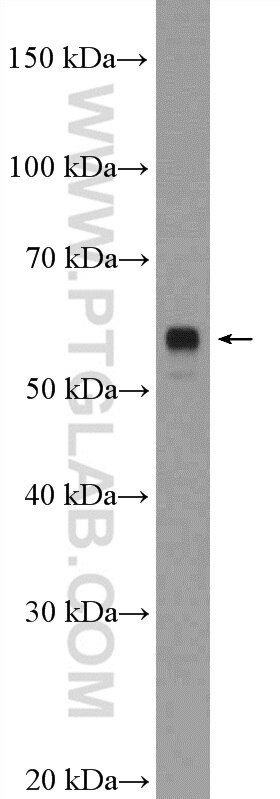Anticorps Polyclonal de lapin anti-LRRTM2
LRRTM2 Polyclonal Antibody for WB, ELISA
Hôte / Isotype
Lapin / IgG
Réactivité testée
Humain, souris
Applications
WB, IP, ELISA
Conjugaison
Non conjugué
N° de cat : 23094-1-AP
Synonymes
Galerie de données de validation
Applications testées
| Résultats positifs en WB | tissu de moelle épinière de souris |
Dilution recommandée
| Application | Dilution |
|---|---|
| Western Blot (WB) | WB : 1:500-1:1000 |
| It is recommended that this reagent should be titrated in each testing system to obtain optimal results. | |
| Sample-dependent, check data in validation data gallery | |
Applications publiées
| IP | See 1 publications below |
Informations sur le produit
23094-1-AP cible LRRTM2 dans les applications de WB, IP, ELISA et montre une réactivité avec des échantillons Humain, souris
| Réactivité | Humain, souris |
| Réactivité citée | Humain |
| Hôte / Isotype | Lapin / IgG |
| Clonalité | Polyclonal |
| Type | Anticorps |
| Immunogène | LRRTM2 Protéine recombinante Ag19422 |
| Nom complet | leucine rich repeat transmembrane neuronal 2 |
| Masse moléculaire calculée | 516 aa, 59 kDa |
| Poids moléculaire observé | 59 kDa |
| Numéro d’acquisition GenBank | BC126408 |
| Symbole du gène | LRRTM2 |
| Identification du gène (NCBI) | 26045 |
| Conjugaison | Non conjugué |
| Forme | Liquide |
| Méthode de purification | Purifié par affinité contre l'antigène |
| Tampon de stockage | PBS with 0.02% sodium azide and 50% glycerol |
| Conditions de stockage | Stocker à -20°C. Stable pendant un an après l'expédition. L'aliquotage n'est pas nécessaire pour le stockage à -20oC Les 20ul contiennent 0,1% de BSA. |
Informations générales
Leucine-rich repeat transmembrane proteins (LRRTMs) are synaptic cell adhesion molecules. LRRTMs are highly localized in the postsynaptic density and play various roles in the formation, maturation, and function of synapses (PMID: 25951919). LRRTM2 acts as a post-synaptic ligand of Neurexins. LRRTM2 regulates excitatory synapse development and function in the vertebrate nervous system (PMID: 20064387).
Protocole
| Product Specific Protocols | |
|---|---|
| WB protocol for LRRTM2 antibody 23094-1-AP | Download protocol |
| Standard Protocols | |
|---|---|
| Click here to view our Standard Protocols |


